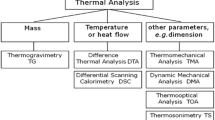Abstract
The internationally accepted definition of thermogravimetry is ‘a technique whereby the weight of a substance, in an environment heated or cooled at a controlled rate, is recorded as a function of time or temperature ’ [1]. Thus, it follows that the basic requirements of the technique are a source of heat, the measurement of temperature and a means of weighing.
Zusammenfassung
Die international anerkannte Definition der Thermogravimetrie lautet: “Ein Verfahren, wobei das Gewicht einer Substanz in einer mit kontrollierter Geschwindigkeit aufgeheizten oder abgekühlten Umgebung als Funktion der Zeit oder der Temperatur aufgezeichnet wird” [1]. Daraus folgt, da\ die grundlegenden Voraussetzungen dieses Verfahrens eine WÄrmequelle sowie die Messung von Temperatur und eine Möglichkeit zur Gewichtsbestimmung sind.
Similar content being viewed by others
References
R. C. Mackenzie, Talanta, 16 (1969) 1227.
F. Szabadváry, ‘History of Analytical Chemistry’. Pergamon Press, Oxford 1966, Chapters I & II.
The authors are indebted to Mr W. E. Carrington, late of the Division of Materials Applications, National Physical Laboratory (NPL), Teddington, Middx, U.K., for providing information on early electric furnaces from the NPL archives.
W. E. K. Middleton, ‘A History of the Thermometer and its use in Meteorology’, Johns Hopkins, Maryland 1966.
J. Prinsep, Phil. Trans. R. Soc., (1828) 79.
V. Regnault, Ann. Chim. Phys., 4 (1842) 5; 64.
Holborn and Wien, Wied. Ann., 47 (1892) 107.
Holborn and Valentiner, Ann. Phys., 22 (1907) 1.
T. J. Seebeck, Ann. Phys., 6 (1826) 130, 253.
A. C. Becquerel, Ann. Phys., 31 (1826) 371.
C. S. M. Pouillet, C. R. Hebd. Séanc. Acad. Paris, 3 (1836) 782.
A. C. Becquerel, Ann. Chim. Phys., 68 (1863) 49.
M. Avenarius, Ann. Phys., 119 (1863) 406.
T. G. Tait, Trans. R. Soc. Edinb., 27 (1872) 125.
H. L. Le Chatelier, C. R. Hebd. Séanc. Acad. Paris, 102 (1886) 819.
A. Stansfield, Phil. Mag., 46 (1898) 59.
C. W. Siemens, Proc. R. Soc., 19 (1871) 443.
H. L. Le Chatelier, C. R. Hebd. Séanc. Acad. Paris, 114 (1892) 214.
J. R. Partington, ‘Origins and development of Applied Chemistry’, Longmans Green, London 1935, pp. 8,30.
N. Lemery, ‘Cours de Chemie’, 5th Ed., Paris 1675, p. 172.
R. Boyle, Phil. Works, 2 (1738) 388.
J. Black, ‘Experiments upon Magnesia alba, Quicklime and other alcaline substances’, Edinburgh 1756.
A. L. Lavoisier, ‘Traité élémentaire de Chimie’, Paris 1789.
B. Higgins,‘Experiments and observations made with the view of improving the art of composing and applying calcareous cements and of preparing quicklime. Theory of these arts: and specification of the Author's cheap and durable cement; for building incrustation or stuccoing and artificial stone, London 1780.
J. Wedgwood, Phil Trans. R. Soc., 72 (1782) 305.
E. Lovejoy, Clayworker, (1886) [In H. E. Ashley Ind. Eng. Chem., 3 (1911) 91.]
H. L. Le Chatelier, C. R. Hebd. Séanc. Acad. Paris, 104 (1887) 1443. Also: Bull. Soc. Fr. Minér. Cristallogr., 10 (1887) 204.
E. Warburg and T. Ihmori, Ann. Phys. Chem., (neue folge), 24 (1886) 481.
W. Nernst, Z. Elektrochem., 9 (1903) 622.
W. Nernst and E. H. Riesenfeld, Ber. Dt. Chem, Ges., 36 (1903) 2086.
C. Duval, Chim. Analyt., 44 (1962) 191.
Reference 30 p. 2089.
Reference 30 p. 2090.
O. Brill, Z. Allg. Anorg. Chem., 45 (1905) 275.
C. Duval, C. R. Hebd. Séanc. Acad. Paris, 224 (1947) 1824.
L. Erdey, F. Paulik, G. Svehla and G. Liptay, Z. Anal. Chem., 182 (1961) 329.
O. Brill, Ber. Dt. Chem. Ges., 38 (1905) 140.
Author information
Authors and Affiliations
Rights and permissions
About this article
Cite this article
Keattch, C.J., Dollimore, D. Studies in the history and development of thermogravimetry. Journal of Thermal Analysis 37, 2089–2102 (1991). https://doi.org/10.1007/BF01905580
Issue Date:
DOI: https://doi.org/10.1007/BF01905580




